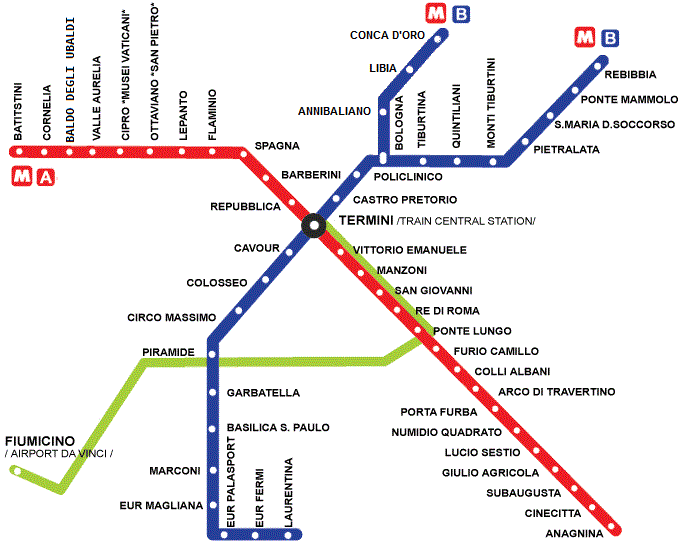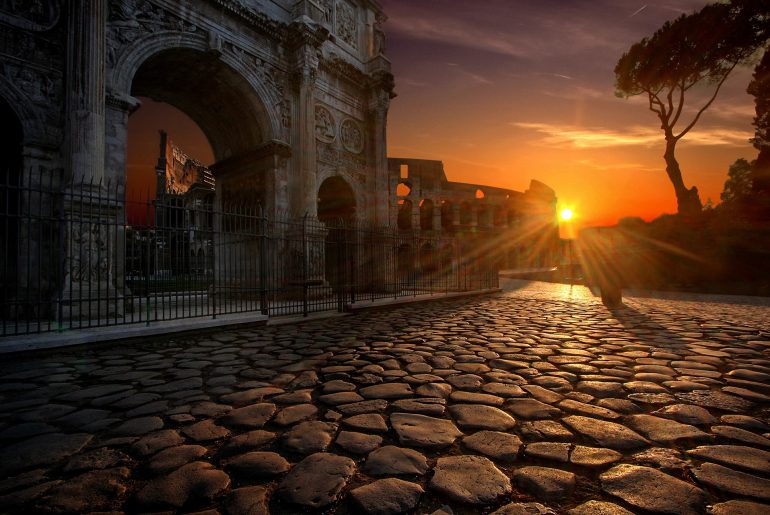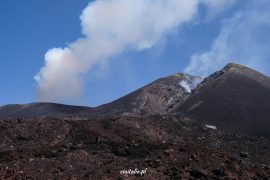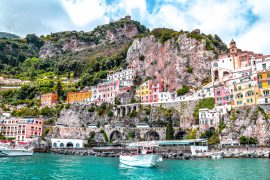Rome is the capital of Italy and also the largest city in the country. It is located on the Tiber River. It is the third largest city in the European Union. The founder and first king of Rome was Romulus, who, according to Livy, founded the city in 753 B.C. on seven hills located on the eastern side of the Tiber River. These are: Aventine, Palatine, Quirinal, Viminale, Celius, Esquiline and Capitoline. Rome has been known as the "capital of the world" or the "Eternal City" since ancient times. Today it is the largest tourist center in Italy. It is a city with a beautiful history, perfectly preserved monuments, famous for its splendor and architectural wealth. It is where crowds of tourists from all over the world come every year. This can be felt especially during the summer season, so when planning a trip during this period, you need to prepare for considerable queues. It is said that someone who visits Rome at least once will certainly return to it. It is a city that will delight both history lovers and those who want to experience the unique climate, cuisine, as well as the cultural heritage of the place. In addition to visiting Rome's most popular sites, you can also go to the coast, which is more than 30 kilometers from the city center itself. This is a great convenience, especially for those wishing to combine sightseeing with beachcombing. There are also numerous aqua parks, amusement parks in the area, which will be ideal for a family trip. One of the attractions is also a cruise on the Tiber River. Rome is a city ideal for those who enjoy physical activity. There are special routes for cycling or walking enthusiasts. Italy's capital is a place you definitely need to visit to experience the unique architecture, local specialties and delve into the history associated with the city once called "the center of the world."
Attractions in Rome
Di Trevi Fountain
This is the most popular fountain in Rome and one of the most visited places in the city. It is located in the historic center of the city. It was created during the Baroque period. It was designed by Niccolo Salvi. The fountain is located in the Piazza di Trevi, and in the central part of the fountain is a statue of Okeanos/Neptune, and next to him are the Tritons (in Greek and Roman mythology they are half people and half fish). Crowds of tourists visiting this place throw a coin into the fountain. This has to be done in a special way. One should turn one's back to the fountain and throw the coin with the right hand over the left shoulder. Legend has it that one is then sure to still return to Rome. Interestingly, throwing two coins means romance and three coins means marriage. Thousands of tourists visit the place and cherish this tradition. About 3,000 euros are fished out there daily. The money thrown in by tourists is taken by the authorities and used for the maintenance of the monuments or for charity. It is forbidden for tourists to fish out the coins. The Di Trevi Fountain can even be seen on the big screen, as shown in the film La Dolce Vita.
Colosseum
This is an amphitheater in Rome, it was built between 70-72 and 80 AD by Vespasian and Titus. It is a symbol of Italy's power and a place with a remarkable history that is also very violent. Once in Colosseum gladiatorial fights were arranged, which were slaves distinguished by their enormous strength. In addition, animal fights were also organized. It is estimated that about 500,000 people and more than a million wild animals lost their lives there. There is a belief that the martyrdom of Christians took place in the Colosseum. Every year on Good Friday, the Stations of the Cross are held there, often with the participation of the Pope himself. The auditorium of the Colosseum accommodates 50,000 seats and several thousand standing places. In the stands, seats were divided according to social status and gender. Women occupied the most distant seats. The Colosseum is a structure that is located in the very center of Rome. It is one of the best preserved monuments built in such remote times. It can accommodate 3,000 people. Since 1990, the Colosseum, along with the entire historic center of Rome, has been listed as a UNESCO World Heritage Site, and in 2007 the structure was named one of the seven new wonders of the world.
Roman Forum
This is the most famous and oldest square in Rome. It is surrounded by six of the seven hills: the Capitoline, Palatine, Celius, Esquiline, Viminale and Quirinal. The Roman Forum is considered the political, social and religious center of ancient Rome. Among the most important buildings located there are: Temple of Castor and Pollux, Romulus, Saturn, Vesta, Venus and Roma, Antoninus and Faustina, Caesar, Vespasian and Concord. You can also find three Basilicas, four triumphal arches, and the Curia, Regia, Fokas column i Tabularium. Walking through the Roman Forum, you may also come across the Lapis niger. This is a monument with a legend associated with it. According to it, the Roman Forum is the burial place of Romulus, who was the founder of Rome, and Lapis niger is the place of his death. The inscription on the stone reads: "Whoever violates this place will be condemned to the hell gods." In addition to visiting the square itself, you can also go to the main observation deck of the Palatine Hill, which offers an amazing view of the Roman Forum.
Basilica of St. John Lateran
The full name of the place is the Papal Arch-Basilica of the Most Holy Savior, St. John the Baptist and St. John the Evangelist in the Lateran. Mother and Head of All the Churches of the City and the World. It is the cathedral of the Bishop of Rome and the first church established in the Italian capital. The beginning of the 4th century is believed to be its foundation. In 896 it was damaged by an earthquake, then rebuilt by order of Pope Sergius III. Subsequently, two more fires destroyed the basilica, which was finally rebuilt in the 15th century. The interior of the building is divided by columns into five naves. The basilica has a pediment with 15 statues - of Christ, St. John the Baptist, St. John the Apostle and the Doctors of the Church. In the main nave are statues depicting the 12 Apostles, while in the side aisles are located the tombstones of popes. The basilica is considered one of the most beautiful monuments in Rome. It is located in Piazza di S. Giovanni in Laterano, and entry is free. It's worth mentioning that when going to the Basilica you should be dressed appropriately (you must have your arms and legs covered).
Gianicolo (Janiculum)
It is one of the highest hills in Rome. It is located on the right bank of the Tiber River. However, it is not counted among the seven hills on which Rome was founded. According to legend, the name comes from the god Janus, to whom a temple was built at the top. Today this hill is one of the most beautiful viewpoints. On the hill is a monument to Garibaldi (Italian revolutionary, soldier and politician who lived in the 19th century). It is worth mentioning that there is a tradition associated with Gianicolo. Every day at noon, cannon shots can be heard. This is a tradition that began in 1847 and has lasted about 170 years (except during and just after World War II). At first the cannon was located on St. Angelo's Castle, then on Monte Mario Hill, but was eventually placed on the Janikulum. It's worth a trip to this place before noon to see and hear the tradition so cherished for so many years.
Other attractions in Rome - what else to see?
A place you should definitely visit while in Rome is the Spanish Steps, which lead from Piazza di Spagna to the Trinità dei Monti church. Built between 1723 and 1725, a flower festival or Festa della Primavera is held here every year, and a Christmas nativity scene is set up during the holidays. There are several superstitions about the place. One says that one must not eat there because it will bring misfortune, and another says that by taking a picture of yourself on the Spanish Steps with your head down, you can ensure good luck and happiness in life. The Botanical Garden in Rome also deserves special attention. It is run by the Sapienza University. It houses about 3,000 plants, including about 300 medicinal plants. Walking around this place, you can reach the Rose Garden and the Japanese Garden, among others. Each of these places has unique vegetation. It will certainly be an ideal place for those who want to take a break from the hustle and bustle of the city and stroll among nature. A full ticket to the Botanical Garden costs €13, and a reduced ticket costs €10 (valid for children aged 4-18, people over 65, students, APPI members). Free entrance is for children under 3 years of age, as well as people with disabilities and their caregivers. It is worth mentioning that the Botanical Garden can also be visited with a guide. Also noteworthy is the Via Appia, the oldest Roman road, located in the south of the Apennine Peninsula. It originally connected the Italian capital with Campania, in order to supply Rome with agricultural products there. Numerous tombs and catacombs could be spotted along the path, as this area was once a burial ground. Today we can observe numerous remnants of this road, some of which are even used by cars in the city of Velletri. Other places that are considered among the most popular in Rome are the Vatican Museums, which house a large collection of works collected by popes. They include: Pinacoteca, the Pio-Clementin Museum, the Gregorian Etruscan Museum, the Missionary-Ethnological Museum and the Chiaramonti Museum. Each has individual works from a different historical period.
Attractions for children
Rome is a city where you can boldly visit with your little ones. They can enjoy many of the sights for free or with great relief. There are also places that are sure to appeal to families with children. Many people go to the Bioparco di Roma. This is a zoological garden that was established in 1911. It has an area of about 17 hectares. There you can see about 1,200 species of animals including hippos, Cape penguins, wolves, turtles and elephants and giraffes. Another attraction not only for children, but also for the whole family is the Hydromania aquapark. It features slides, tunnels, waves and a Jacuzzi, among other things. The price for an adult ticket costs €25, and a child under 12 years old and under 1.50 inches tall costs €19.00. Another attraction for both children and adults is the Magicland amusement park about 50 km from Rome. There are numerous merry-go-rounds, roller coasters, a Ferris wheel and many other attractions that will please more than just the little ones.
Beaches in Rome
One of the most popular districts of Rome is Ostia, 25 kilometers from the center. It is the most visited place among tourists looking to relax in the hot sun and take a swim on occasion. There are both private and public beaches there. The most popular of these is Capocotta, which is divided into several parts. Among others, there is a family beach, a wild beach, as well as a nudist zone. At each section you can find sunbed and umbrella rentals, as well as a bar and parking. Another beach about 60 km from Rome is Anzio. The water here is transparent and shallow, making it ideal for families with children. Another beach that is certainly not one of the crowded places is Spiaggia del Prigioniero, about 100 kilometers from Rome. Its name translates as "prisoners' beach," due to a soldier who found refuge there during World War II. Not far from the beach is also the Circeo National Park, as well as several caves that are certainly worth a visit.
How to get to Rome?
Those wishing to visit the Italian capital can choose to fly from Krakow, Poznan Warsaw and Wroclaw. One-way tickets for one person can be found starting at 79 PLN. Upon arrival at the airport, you can reach the center by ATRAL bus, cab or rent a car. Another option for getting to Rome is to travel by car. The route to Rome is about 1,700 kilometers. If you want to use this means of transport, you should remember about tolls, vignettes and parking. Traveling by your own car guarantees beautiful views, and the fact that on the spot you do not have to worry about the means of transport when wanting to go to more distant places, or having an overnight stay outside the city center. If you choose to travel by car, you can also stop in several places, while arriving at your destination to visit other European cities such as Vienna or Brno, Venice, Florence or Bologna.
Public transportation
Rome is a city where public transportation is very well developed. You can use the subway, buses and the overground train. The historic part of the city is best explored on foot, so as not to miss the most important monuments, which are located not far from each other.
Metro
Rome has three metro lines, which can easily take you to remote parts of the city. A single ticket (BIT) costs 1.5 euros. It is valid for 100 minutes and, importantly, can be used only one way.

Buses
Another means of transportation that can be used are buses. However, it is worth mentioning that tickets cannot be bought from the driver. Before boarding the bus, you need to punch a ticket you purchased in advance (for example, at a kiosk). This is one of the most popular means of transportation in Rome, so buses can be crowded during the summer season. You can also use the overground railroad, which has 3 lines and is primarily used for travel outside the city.
What to eat in Rome?
Italian cuisine is famous all over the world. It is famous not only for the excellent quality of its products, but also for the small number of ingredients, which makes the dishes simple yet unique. The first local specialty you absolutely must try when visiting Rome is bucatini all'amatriciana. It's pasta with an essential sauce of smoked guanciale, tomatoes and pecorino cheese. Another dish for which the Italian capital is famous is abbacchio alla cacciatora, or fried lamb with garlic, rosemary and sage. Of the local dishes, especially recommended is saltimbocca alla romana which is veal in prosciutto ham and sage, marinated in white wine and then sautéed. Another dish is gnocchi alla romana which are small noodles usually served with butter, garlic and herbs. For lovers of sweets, maritozzo, which is a raisin roll filled with whipped cream, is especially recommended.
Weather in Rome
The warmest months in Rome are June, July, August and September. The average daytime temperature during this period is over 27°C, and the water temperature in the sea is over 22°C. The coldest months are December, January and February. Then the average daytime temperature is about 12°C. The most frequent rainfall in this city is in November, December and January. Wanting to take advantage of the beautiful weather, while wanting to avoid large crowds of tourists, it is best to visit Rome in May or October, when the average daytime temperature is over 22°C.
Accommodation in Rome
In Rome you will find a wide range of accommodations. Due to the fact that it is the largest city in Italy, the choice is really quite large. Prices largely depend on the location, as well as the amenities for guests. The first accommodation that is sure to appeal to even the most discerning visitor is a five-star resort called Rome Cavalieri, located on a hill in the Montemario district. It is the most popular and one of the best-rated accommodations in the area. The resort is about a 25-minute drive from the Colosseum. It has a number of amenities for guests - a 2,500-square-meter wellness area, 2 restaurants (one of which, located on the rooftop, has been honored with three Michelin stars) and 4 bars. each room has a balcony overlooking the garden or the city center. The resort also has tennis courts, a fitness track as well as a sauna area and swimming pool. The price for one night for two people including breakfast is PLN 1,183. Another establishment worth noting is the Hotel Borromeo, which is located 5 minutes away from the subway station. Walking down the street where this establishment is located, you can reach the city center. It is a quiet, intimate and very atmospheric place. Breakfast is served on the roof terrace. The price for one night for two people including breakfast is PLN 372. Another accommodation worthy of attention especially for beach lovers is Hotel La Scaletta, located near the seashore in Ostia (about 30 minutes from the center of Rome). Next to the hotel there are numerous bars and restaurants, the beach and the promenade. The price per night for two people is 266 PLN.





